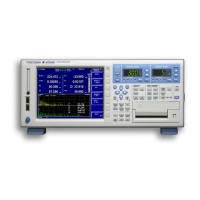13-17
IM WT3001E-51EN
Cycle-by-Cycle Measurement
13
Explanation
• Display When the Cycle-by-Cycle Measurement Is Complete
A display example is shown below.
List display page
Displays the current page number.
measurement status
Cycle by Cycle
Synchronization source
for measurement
Measurement cycle count
Measurement cycle number
Detection of peak over-range data
For voltage (U), current (I), speed, and torque, + or - is
displayed in front of the data value if peak over-range
occurs during the measurement of the cycle for which
the data is displayed.
• +: Positive peak over-range
• -: Negative peak over-range
• ±: Positive and negative peak over-range
Hardware detection of peak over-range
Indicated if any hardware peak over-range is
detected during the measurement of all cycles
Note
• If the synchronization source signal is distorted or high-frequency noise is superimposed on
the signal, zero-crossing other than that of the fundamental frequency occurs. As a result,
a range different from the cycle of the fundamental frequency may be measured. If this
happens, turn ON the frequency filter.
• If the level of the synchronization source signal is less than the zero-crossing detection
level, the zero-crossing cannot be detected correctly. As a result, the measured values may
be unstable, or a timeout may occur.
• If the timeout value is shorter than the product of the period of the synchronization source
signal and the measurement cycle count, timeout always occurs, and the measurement
cannot be completed.
• Peak Over-Range Detection
There are two methods for detecting peak over-range.
• Detection by data
Detects peak over-range in the data from the A/D converter during the
measurement of the cycle for which the data is displayed.
• Detection by hardware
Detects peak over-range that cannot be detected using the "detection by data"
method such as pulse noise with a peak width that is shorter than the sampling
interval of the A/D converter.
If a peak over-range is detected, the data of the cycle-by-cycle measurement may not
be correct. Increase the measurement range so that peak over-range does not occur.
13.4 Executing the Cycle-by-Cycle Measurement

